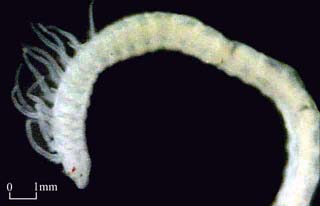Order Spionidae
Family Spionidae
Features |
| Body: |
elongated and flatten; many segments |
| Prostomium: |
anteriorly blunt; with frontal horns, or
pointed; no appendage |
| Eye: |
absent, 2 or 4 |
| Antennae: |
1 |
| Cirri: |
absent or 2 |
| Palp: |
2 or 4; at postectal corners of prostomium |
| Pharynx: |
absent |
| Parapodium: |
biramous; parapodial lobes cirriform or
foliose |
| Setea: |
simple including capillaries and bi- or
multidentate, hooded or non-hooded hooks |
| Anal cirri: |
2 or 4 |
| (Fauchald 1977) |
Biological Notes
Spionids are very common in all
environments. Some spionids such as Polydora and Boccardia
are burrowers in calcareous substrata or in rock. Some species of Polydora
live in soft limestone, dead coral and living mollusc shells. Scolelepis
burrows in intertidal sandbanks where there is sufficient water movement to keep the
detritus moving. Malacoceros burrows in crevices filled with mud. Spio
often forms dense colonies on sandbanks (Day 1967). Others build permanent
tubes in soft substrata or are free living in sands and muds. Minuspio
cirrifera are very useful sedentary worms that can be used as indicator of organic
pollution. They dominate in Tolo Habour, Tolo Channel and Mirs Bay where is
polluted from sewage and development activities (Thompson and Shin 1983).
Prionospio saccifera is a new species reported from Hong Kong and Red Sea (Mackie and
Hartley 1990). It was found in Mirs Bay, Tolo Channel, Jone's Cove and Long
Harbour.
Spionids are typical
deposit feeders. They stretch out a pair of long peristomial tentacles or
palps over the substratum to gather food particles. Most of them lay large
eggs which are enclosed in tough egg-capsules. The eggs may be liberated
directly into the seawater and all development takes place in the plankton.
Some eggs are protected inside the burrow during the early development (Day 1967).
Genera and Species Reported in Hong Kong
Aonides oxycephala
Laonice cirrata
Malacoceros sp.
Minuspio cirrifera
Paraprionospio pinnata
Polydora cf. socialis
Polydora cf. tentaculata
Polydorella novaegeorgiae
Prionospio malmgreni
Prionospio saccifera*
Pseudopolydora sp.
Rhynchospio sp.
Scolelepis sp.
Spio sp.
Spiophanes bombyx
* new species |
